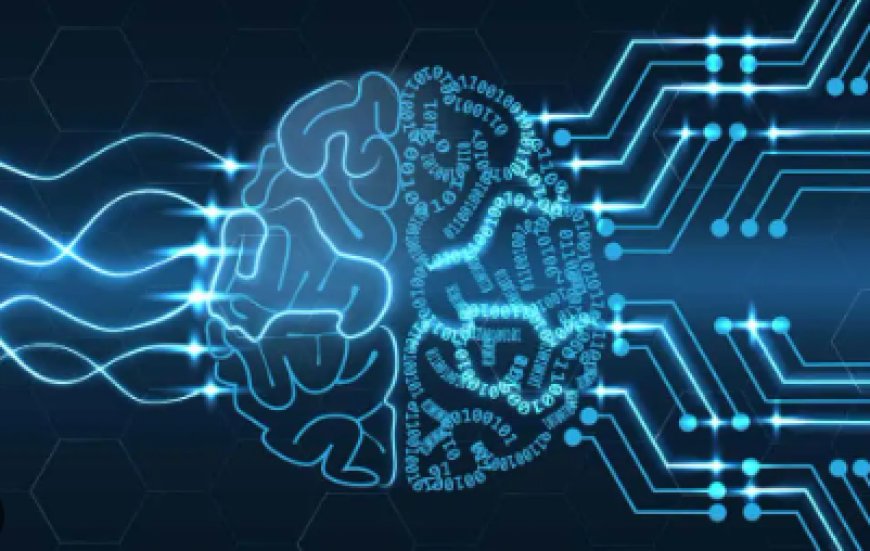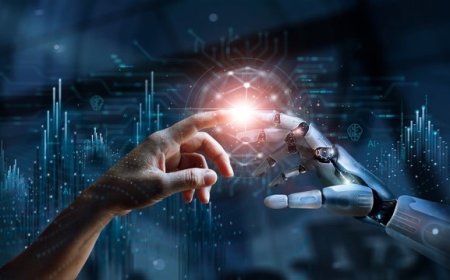Understanding Artificial Intelligence (AI)
Explore the concept, applications, and impact of AI in different industries. Gain insights into machine learning, robotics, and natural language processing.

Artificial Intelligence (AI) is a revolutionary technology that has captured the imagination of the world. In this blog, we will explore what AI is, its applications, types, historical context, and the future it holds. From its definition to real-life examples and its intersection with machine learning, let's dive deep into the fascinating realm of AI.
What is Artificial Intelligence?
Artificial Intelligence, often referred to as AI, is a branch of computer science that aims to create intelligent machines capable of simulating human-like decision-making processes. AI enables machines to perceive, learn, reason, and respond, leading to a wide array of applications across various domains.
Artificial Intelligence (AI) refers to the simulation of human intelligence in machines that are programmed to think and act like humans. It involves the development of computer systems capable of performing tasks that typically require human intelligence, such as visual perception, speech recognition, decision-making, and problem-solving. AI technologies aim to process vast amounts of data, learn from experience, and adapt to new inputs, allowing them to make predictions, recognize patterns, and improve their performance over time. From virtual assistants and chatbots to autonomous vehicles and advanced data analytics, AI is transforming various industries and becoming an integral part of our daily lives. As AI continues to evolve and develop, it holds the potential to revolutionize how we live, work, and interact with technology in the future.
Historical Context and Evolution of AI
The history of AI traces back to the 1950s when the concept of machines imitating human intelligence was first explored. From early research to significant breakthroughs, we'll explore the key milestones that shaped the development of AI.
The historical context of Artificial Intelligence (AI) dates back to the mid-20th century when the concept of creating intelligent machines first emerged. The term "Artificial Intelligence" was coined during a workshop at Dartmouth College in 1956, which marked the birth of AI as a field of study. Early researchers were optimistic about creating machines that could mimic human intelligence and solve complex problems.
The 21st century brought AI into mainstream prominence with breakthroughs in areas like natural language processing (NLP), computer vision, and robotics. The rise of big data and advances in computational capabilities fueled the growth of AI applications across various industries, from virtual assistants like Siri and Alexa to self-driving cars and advanced recommendation systems.
Today, AI continues to evolve rapidly, driven by deep learning, reinforcement learning, and other advanced techniques. AI-powered technologies are transforming healthcare, finance, manufacturing, and many other domains, heralding a new era of human-machine collaboration and possibilities.
Types of Artificial Intelligence
AI can be categorized into three main types: Narrow AI, General AI, and Superintelligent AI. We will delve into each type, understanding their capabilities and limitations.
-
Narrow AI (Weak AI):
Narrow AI, also known as Weak AI, refers to AI systems designed to perform specific tasks and excel in a limited domain. These AI systems are highly specialized and lack the ability to generalize their knowledge to tasks beyond their designated scope. Examples of narrow AI include virtual assistants like Apple's Siri and Amazon's Alexa, which can understand and respond to specific voice commands but cannot perform tasks outside their predefined functionalities. Narrow AI is prevalent in various industries, from recommendation systems in e-commerce to fraud detection in finance.
-
General AI (Strong AI):
General AI, also known as Strong AI, is a theoretical concept where AI systems possess human-like intelligence and the ability to understand, learn, and reason across a wide range of tasks. Unlike narrow AI, which is task-specific, general AI would exhibit cognitive abilities comparable to humans, allowing it to transfer knowledge from one domain to another seamlessly. However, achieving true General AI remains a significant challenge, and its development is a subject of ongoing research and debate.
-
Superintelligent AI:
Superintelligent AI goes beyond General AI and refers to AI systems with intelligence surpassing that of humans in virtually all domains. This level of AI, often portrayed in science fiction, is considered speculative and futuristic. The concept of Superintelligent AI raises complex ethical and existential questions, as it would have the potential to outperform humans in decision-making, problem-solving, and innovation.
While Narrow AI is prevalent today and continues to advance, the realization of General AI and Superintelligent AI remains speculative and uncertain. As AI research progresses, understanding the distinctions between these types is crucial in shaping the ethical and practical considerations surrounding AI's impact on society, the workforce, and human-machine interactions.
Application of Artificial Intelligence
AI has found applications in numerous fields, including healthcare, finance, transportation, education, and more. We'll explore how AI is transforming these industries and revolutionizing various processes.
-
Virtual Assistants: AI-powered virtual assistants like Siri, Alexa, and Google Assistant provide voice-activated information and perform tasks.
-
Natural Language Processing (NLP): AI enables machines to understand and process human language, facilitating chatbots and language translation.
-
Recommendation Systems: AI-based algorithms recommend products, movies, or content based on user preferences and behavior.
-
Image and Speech Recognition: AI can analyze and identify objects, faces, and speech patterns, used in security and accessibility applications.
-
Autonomous Vehicles: AI powers self-driving cars, enabling them to perceive the environment and make real-time driving decisions.
-
Healthcare: AI is applied in medical imaging, diagnosis, drug discovery, and personalized treatment plans.
-
Finance: AI automates financial tasks, fraud detection, credit scoring, and algorithmic trading.
-
Robotics: AI-driven robots perform tasks in manufacturing, logistics, and healthcare, enhancing efficiency and safety.
-
Gaming: AI is used to create intelligent, challenging opponents and generate realistic virtual worlds.
-
Personalized Marketing: AI analyzes user behavior and data to deliver targeted advertisements and personalized content.
-
Predictive Analytics: AI predicts future outcomes and trends, used in sales forecasting, demand planning, and risk management.
-
Virtual Reality (VR) and Augmented Reality (AR): AI enhances immersive experiences, adapting to user interactions in real-time.
AI and Machine Learning
AI and Machine Learning are closely related fields within the realm of Artificial Intelligence. While AI encompasses a broader concept of creating intelligent machines, Machine Learning is a subset that enables these machines to learn from data and improve their performance without being explicitly programmed. Machine Learning algorithms allow AI systems to recognize patterns, make predictions, and adapt to new information, playing a crucial role in various AI applications, from natural language processing and image recognition to recommendation systems and autonomous vehicles. By combining AI and Machine Learning, we unlock the potential for machines to continuously evolve and enhance their capabilities, paving the way for more sophisticated and impactful AI solutions in the future.
Domains of AI and Real-life Examples
From Natural Language Processing (NLP) to Computer Vision and Robotics, AI encompasses various domains. We'll examine real-life examples of AI applications in each domain.
Natural Language Processing (NLP): NLP focuses on enabling machines to understand and interpret human language. Real-life examples include virtual assistants like Siri and chatbots that provide customer support and respond to user queries.
Computer Vision: Computer Vision involves AI systems that can perceive and interpret visual information from images or videos. Examples include facial recognition systems, self-driving cars' object detection, and medical image analysis.
Robotics: Robotics combines AI and automation to create intelligent machines capable of performing physical tasks. Real-life examples include industrial robots used in manufacturing, surgical robots for minimally invasive procedures, and autonomous drones for surveillance and delivery.
Recommendation Systems: These AI-powered systems offer personalized suggestions to users based on their preferences and behavior. Examples include streaming platforms like Netflix recommending movies and e-commerce websites suggesting products.
Expert Systems: Expert systems use AI to mimic human expertise in specific domains. They are employed in fields like medicine, law, and engineering for diagnosis, legal advice, and problem-solving.
Autonomous Systems: Autonomous AI systems can make decisions and take actions without human intervention. Examples include autonomous vehicles, drones, and smart home devices.
Virtual Agents and Avatars: Virtual agents and avatars interact with users, providing assistance and entertainment. Examples include virtual customer service representatives and AI-powered characters in video games.
Financial Services: AI is used in finance for fraud detection, credit risk assessment, algorithmic trading, and personalized financial advice.
Healthcare: AI finds applications in medical imaging analysis, disease diagnosis, drug discovery, and personalized treatment plans.
These examples highlight the diverse and practical applications of AI across various domains, demonstrating its transformative potential and impact on numerous industries and aspects of daily life.
Learning Artificial Intelligence
For those eager to learn AI, we'll provide valuable resources, online courses, and platforms to kickstart their journey into the exciting world of AI.
Learning Artificial Intelligence (AI) offers an exciting journey into the world of intelligent machines. It involves gaining expertise in programming, machine learning algorithms, neural networks, and data analysis. Online courses, tutorials, and resources provide aspiring learners with the knowledge and skills needed to develop AI applications and contribute to the growing field of AI research and innovation. Whether one is a beginner or an experienced programmer, learning AI opens doors to diverse opportunities in cutting-edge technologies that are shaping the future.
Artificial Intelligence is reshaping our world in ways previously thought impossible. As AI continues to evolve, understanding its applications, types, and potential is essential. Embracing AI responsibly will pave the way for a future that is truly empowered by the wonders of artificial intelligence.
Artificial Intelligence (AI) is a transformative technology that continues to revolutionize industries and daily life. From virtual assistants and self-driving cars to advanced data analysis and personalized experiences, AI's potential is limitless. Embracing AI responsibly and investing in its development will drive progress, ushering in a new era of innovation, efficiency, and possibilities for a better and more connected world. As we navigate the future of AI, ethical considerations and responsible deployment will be critical to ensure that AI benefits humanity and enhances our collective well-being.












































